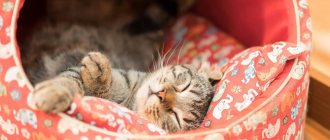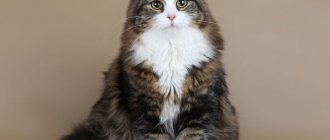What types of litter trays are there for cats? How to use them. Which cat litter to choose?
Owners of tailed furry pets living in apartments with their owners need to choose a tray to which the cat will quickly get used to and will not feel discomfort in order to fulfill their natural needs.
When choosing a tray or other design for a cat, take into account the natural instincts of an animal such as a feline:
- cats do not like to leave a smell behind them, they are ambush animals, so the home tray should be washed thoroughly, and the litter should “remove” the smell as best as possible.
- for the same reason, the cat must definitely rake in its items, it must make the appropriate movements with its paw.
- cats prefer to do their toilet chores so that no one is watching them at this moment; they, of course, are not shy, they are secretive.
It must be remembered that the success of training a cat to use a litter box largely depends on the configuration of the device itself and its location in the house. You can read about how to train a small kitten or an adult cat to use a litter box in this article.
Types of cat litter boxes
Today, the choice of cat litter boxes is wide: closed, with carbon filters, trays for very small kittens, there are models for toilet training a cat... How to choose from all this variety and at the same time ensure comfort for your pet? To begin with, you should familiarize yourself with the entire range.
The most common and very cheap tray with a double bottom. The average price of such a tray is 300 rubles, but you can find it cheaper, for 200 rubles.
Pets will be happy to go to the tray if you choose it correctly
The tray consists of a plastic box and a mesh insert. You can put a filler under the mesh, for example, wood or silica gel, due to this, most of the unpleasant odors will be absorbed. Since the filler does not come into contact with the paws, the area will always be clean. But because of this, a tray with a mesh for a cat can become a reason for a boycott - not being able to bury “its work,” the pet may flatly refuse to go into it.
High-tech cat tray CatGenie 120
- Toilet for kittens with high sides
High sides are needed to prevent the pet from scattering the litter from the tray. If the product is purchased for a small kitten, there should be a recess on one edge so that the baby can climb into it.
- Flat plastic tray with low sides
The most economical and easy to maintain option. It is inconvenient because the filler will always spill over the edge. If your cat really likes to dig, you should pay attention to a cat tray with high sides.
Additional information: you can put a special ribbed plastic mat in front of a regular tray; it will retain some of the filler.
- Closed tray house
For shy people, a toilet that is completely closed (with a door) or partially closed (without one side wall) is suitable. They will not quickly jump out of it without finishing their work if one of the people passes by.
There are a lot of models in this category, they come with a regular door (Bergamo Oliver), a tunnel entrance (Petmate Clean Step) or a hole at the top (Moderna Top Cat).
- Tray with built-in filtration system
This is a tray with one or several grating inserts; fine filler is poured into the topmost one (directly onto the grate).
After the cat goes to the toilet, the contents are sifted and the waste remaining on the mesh is easily removed.
Of the minuses: due to the weight of the filler, it can be difficult to hold and sift, dust rises.
- Self-cleaning dry toilet for cats
A fully automated device that sifts or rinses the filler and removes waste into a special compartment or even into the sewer.
Cons: high price, some models require constant connection to electricity, water and sewerage.
This is interesting! CatGenie 120 is the most expensive dry closet model at the moment. The filler granules are mixed, the excrement is washed down the drain, the filler is washed and dried with hot air. Approximate cost - 35 thousand rubles.
- A simple rectangular tray with a frame on the side
In this option, it is very convenient to replace the absorbent filler - just take out the bag with the old one and tie it. The frame is used to secure the plastic bag in the tray.
Sometimes such a tray is used without bags; due to the frame, the filler hardly spills out. The disadvantages are that cats often tear the bags, and the frame is more difficult to clean than a regular flat tray.
Designed to train a cat to use the toilet. It consists of several inserts inserted into each other; as the cat gets used to it, they are gradually removed until the cat learns to relieve itself while sitting on a regular toilet seat.
You can put your cat’s usual litter into the inserts. It is not recommended to use this type of litter box for small kittens, older cats, or pregnant cats.
Note! Dry toilets also include regular trays with a built-in carbon filter, or a special antibacterial napkin under the filler, which absorbs urine and neutralizes its odor.
- Corner toilet cabinet
In standard apartments of this model, there is only room in the hallway or combined bathroom. Of all the options for corner toilets, it is better to choose one in which the entire door rises up with part of the “ceiling”: this one is easy to clean and has a mount for a scoop (for example, the Moderna Flip model).
Automatic trays
The latest word in cat technology is self-cleaning toilets. They are installed on the floor in a secluded place and have a storage tank for sand. After the cat has gone to the toilet, a centrifuge-type mechanism is automatically activated, drawing feces into a special tank. There are toilets that do without filler at all.
You can purchase a model that connects to a human toilet, where feces are automatically sent through a special pipe. Thus, the human factor when caring for a cat’s litter box is practically reduced to zero.
The advantages of such a tray are:
- there will be no smell;
- always clean;
- the ability to save on filler;
- automatic disinfection with substances that are not dangerous to cats.
But there are disadvantages:
- high price (200-800 US dollars);
- the cat may be frightened by the loud cleaning process and start going to another place (you need to set up automatic cleaning at a sufficient interval after going to the toilet or select manual mode).
Open machine
Closed semi-automatic
Vending machine with drainage
Popular cat litter models
Below is a selection of models from various manufacturers that are in great demand.
NETTA Open
A simple cat litter box with high sides at the back and sides, a lower side at the front and a wide, perforated step to keep litter out of the paws.
Tray toilet NETTA Open
Minimum cost*—950 rub. excluding delivery.
Imac DUO
A regular deep tray with a side and an attached scoop stand. Costs about 1500 rubles.
How to choose the right cat litter box: what to consider when purchasing
This thing can also be of high quality or not. In addition, there are other selection criteria.
Although these are not dishes or toys that a pet can chew, the quality of the material should still be high. A new cat litter box should not smell unpleasant, especially if it is not located in the bathroom.
These animals have a very good sense of smell; the strong chemical smell of plastic can scare them away. The material of the product should also not absorb the odors of cat waste during use.
Note! The plastic should not be too thin and brittle so that the animal is not injured. There should be no protruding sharp burrs left after production along the edges of the product.
- How is waste removed?
The cat tray can be with a regular mesh, a scoop, or it can be fully automatic. It all depends on the owner’s habit, or, in the case of self-cleaning, on the budget.
- Tray size, shape and location in the apartment
A huge Maine Coon may not have enough space in a triangular tray that comfortably accommodates a miniature adult Angora.
When choosing a product, especially online, you need to pay attention to the external and internal dimensions - now you can choose one for any size of animal, from small kittens to really large animals.
The usual location of the tray is a bathroom, corridor, balcony; such trays can be of any type. If it is placed in a living room, it is better to give preference to a closed house, so there will be less unpleasant smell.
If you don’t need filler, you should choose the cheapest and most easy-to-clean options - simple trays or a toilet with a mesh.
Are you on a very limited budget and have several pets? There are a huge selection of inexpensive options! But if the cat is alone, loved and spoiled, and has its own room with toys, then you can choose the most extravagant model.
Note! Animal experts advise placing as many litter boxes at home as there are cats living there, plus one extra. In fact, you need to look at the situation, because it happens that several pets can get by with one tray in turn.
Tray for cats with mesh
The most common, convenient and affordable invention. It consists of a plastic rectangular tray and a plastic mesh placed on top of it. It’s convenient for cats to enter it, do business, and turn around conveniently when they scoop up feces behind them. This type of tray comes in different colors, and the owner decides which color to choose based on his preferences.
A simple cat tray with a mesh.
IMPORTANT: The mesh inside the pot is needed to prevent the cat from getting its paws wet while doing the toilet. But incidents sometimes happen, so it is advisable to lay a rug under such a pot.
A tray with a mesh does not provide for the use of filler; this is the basis for the features of its use:
- After the cat has relieved itself, the tray needs to be washed, since cats are very clean and do not like to do their toilet chores in dirty and unclean places. Also, a tray that is not cleaned for a long time will spread an unpleasant odor throughout the apartment, which is absolutely not necessary for anyone.
- If the owner(s) go away for a long time and cannot clean up after their pet in time, you can purchase two litter trays for the cat.
- You can also use special cat litter for trays in small quantities. This filler neutralizes the smell of animal feces, and in this case, the pet can use it several times. Usually, newspaper is laid on the mesh, and sand is poured on top for cats.
- It happens that cats do not really like to scoop up feces in trays of this design, since the claws on their paws cling to the mesh. Then the owners can look for either trays of a different design, or come up with another solution, for example, laying newspapers on the bottom of the mesh, which they then throw away along with the filler.
How to train a kitten to go to the litter box
The headache of all owners of small kittens and puppies is to teach them to relieve themselves where they need to, and not where they want.
You should choose a tray with low sides so that the baby can climb into it on his own, and add a thin layer of filler to the bottom. You need to put the kitten in the tray after sleep, active games, 20 minutes after eating, stroking its belly. When you first get acquainted with the potty, you should scrape the filler a little with your fingers to interest the baby.
If the kitten has gone big outside the toilet, you need to put the pile in the tray and show it to your pet. As soon as he sits down somewhere with the clear intention of defecating, you need to carefully transfer him to the tray. Places where the kitten mistakenly went should be thoroughly washed so that the animal is not tempted to reuse them for the toilet. Experienced cat owners advise putting food or water there after cleaning, then the pet will disdain to go to the toilet nearby.
Important! You cannot hit the kitten, pull it by the scruff of the neck, or shout at it. This behavior of the owners further aggravates the animal’s reluctance to go to the toilet in a specially designated place.
It’s worth trying different fillers for the litter tray; perhaps the kitten will like some of them more.
Master toilet
Some owners want their cat to go to the toilet and not to his own litter box. Implementing this idea is not difficult: there is a special 21-day program for toilet training a cat, but it is only suitable for older pets. Small kittens cannot cope with this task. If you plan to toilet train your cat in the future, buy him a cheap standard toilet to use for the first time until he grows up.
Having a cat go to the toilet is convenient because... After it all you have to do is wash it off. But, on the other hand, this is not entirely hygienic, because you will go to the same potty with your pet. Besides, what if you both really want to go to the toilet at the same time?
Article continues after advertisement
Recommendations for use
A tray with high sides may be uncomfortable for older cats, so you may need to provide a step or cutout on the side.
If litter is used in a cat's litter box, then it should be covered with a thick layer of 5-6 cm. This amount will allow you to change the contents less often.
A house on a bench - this can also be placed in the corridor of an ordinary apartment, for example, in the hallway
If your cat doesn't bury her waste, she's trying to signal that the litter box is full or doesn't have enough litter.
You need to wash the tray at least once a month, ideally every time you completely change the filler. Products are best used with a neutral odor and wash off easily. You can sprinkle baking soda under the litter; many cat owners claim that this really neutralizes the unpleasant odor.
Important! A cat walking outside can be a carrier of toxoplasmosis or helminthiasis, so children and pregnant women should not come into contact with the litter tray, as infection is most dangerous for them.
Tray houses
An excellent choice for cats, including Scottish cats, is a closed litter box. Below these are ordinary trays with high sides, but on top they have walls and a roof, as well as a door. They are larger than standard and well suited for large cats. In addition, they create a sense of privacy, so this toilet can be placed almost anywhere. In addition, the houses retain odor if you use a door and a special filter.
The houses are more expensive than regular trays: the price starts from $20.
The disadvantages include the fact that not all cats easily master the art of using the door, which must be butted with their heads, to enter and exit the toilet. Many cats are unable to do this. Some people find dangling doors intimidating, so the litter box must be used without a door, which impairs its odor-holding abilities. However, a house even without a door is an excellent solution that cats like so much.
In addition, the appearance of such a tray is more aesthetically pleasing. It can even be made in the form of a vase with flowers (see photo). But you will have to look for such a tray in foreign online stores.
House trays are different. Take a model that has a hinged lid. Otherwise, you will have to disassemble the structure every time during cleaning, which is quite inconvenient.
Article continues after advertisement
Interesting solutions for placing a toilet
Picture 10 Cabinet house: takes up a lot of space, but it's worth it
Oh, this ubiquitous cat litter... It seems like the sides are high and the rug is laid out - no, the cat still manages to carry grains of sand to the master bedroom. Owners of spacious apartments and private houses are lucky in this regard - they will be helped out by special furniture, inside of which you can hide a toilet for cats.
The biggest advantage of this design is a separate “room” with a regular rug on which the filling remains.
Even those cats that are taken to the country for several months a year prefer to relieve themselves in a convenient and clean litter box rather than on the street. Today, there are many different models of cat litter available in stores. When choosing one option or another, you need to make sure that it is first and foremost comfortable for the cat.
How to choose a litter box for a cat
One of the important aspects of creating a comfortable environment for your pet is the proper arrangement of the cat’s toilet. The more you know about your cat's habits, the easier it will be to choose the perfect option, so arm yourself with knowledge and read our review of the best cat litter. We will look at all types of trays (open, closed, with and without bars, with sides, travel and disposable), and also talk about new products - bio- and auto-toilets.
Criteria for evaluating cat litter
The characteristics of the pet and the owner’s preferences in the frequency of cleaning significantly influence the answer to the question: which litter box is the best for a cat. The following criteria will help you decide on the appropriate type of cat litter.
- Material – almost all trays are made of plastic of varying quality. The main thing is to make sure that it does not smell of chemicals and does not bend under slight weight. Cats have a sensitive sense of smell and will simply reject a pungent-smelling litter box.
- Tray design - if you are the owner of a timid cat or someone who likes to rummage through the litter until they go crazy and throw it out of the toilet, then closed toilets with protection from prying eyes and walls to hold the litter inside the structure are suitable for you. The open type is suitable for owners of several cats, as it is immediately clear when cleaning is necessary.
- Size – small trays, although they look neat, are actually only suitable for kittens. An adult cat needs a toilet that is more spacious so that it can easily turn around, and for closed types it is important to choose the height of the top lid, otherwise the cat will not be able to straighten up inside the toilet house.
- The need to use filler - a lattice-limiter will allow you not to spend money on filler, but not every cat will agree to this option; it is better to accustom it to such a tray from a young age.
- Cost – traditional litter boxes with or without bars are cheap, and you can buy two of them at once, which, by the way, cats love. Expensive dry closets and self-cleaning trays are a serious purchase, and it’s worth weighing the pros and cons, because in addition to buying the filler, you will need special cartridges, cleaning products and sprays.
- Ease of cleaning - open toilets are quick to clean, however, in the absence of filler, a difficult-to-clean residue may form in the corners of the tray. Closed toilets should be easy to disassemble and not have hard-to-reach areas where dirt can accumulate.
Review of popular types of litter boxes for cats:
How to equip a toilet for a kitten - choose a tray and place
The first thing is to buy a tray. You need to save money and buy a specialized litter tray that has high sides to prevent debris from scattering when feces are buried in the litter.
Of course, there are cheap options, for example, low plastic pallets with a pallet grid at the bottom, and you can come up with some kind of cat toilet room yourself using improvised materials. But they will be uncomfortable for the cat, and she will begin to avoid relieving herself in the right place.
A deep tray that holds a large amount of litter allows the cat's instincts to work. The animal will happily dig into the litter, dig a hole, use it for its intended purpose and bury excrement. In this case, no specific training of the kitten will be needed - instinctive behavior will work.
Which tray is better to choose for a cat's litter box? Breeders begin toilet training kittens from the age of three weeks, at which point the mother cat ceases to provide them with this need. First, place a shallow plastic container into which fine filler is poured.
For kittens, it's more like a game, until the smartest one learns to dig holes. As soon as one kitten has a proper bowel movement, the rest will do the same.
The best trays for a kitten
Choosing a tray for a kitten is not a difficult task on the one hand, but it is better to approach it wisely. Today we have prepared for you an overview of all types of litter boxes for kittens with advantages and disadvantages. Domestic representatives of the cat breed have a tendency to wash themselves frequently and a certain disgust. Cats do not like dirty bowls with stale food and drink, as well as unclean and uncomfortable litter boxes. When protesting against poor care, they can show enviable obstinacy. Therefore, even a tray for kittens, like a filler, must be chosen after first thinking through various nuances.
How to choose?
How to choose the right litter box for a kitten? Having studied the advantages and disadvantages of popular models of cat litter boxes through experience, professional breeders offer their advice on choosing litter boxes for kittens.
Basic recommendations: first decide on the location of the toilet in order to choose a tray that is suitable in size, and also select a container that is convenient for your pet to visit:
- The sides are neither high nor low, so that it is easy for him to climb in there and at the same time not relieve himself past the tray;
- Sufficient space for free placement;
- Open or closed toilet with a lid, depending on the nature and size of the kitten;
- Do not buy very light open trays: they are easy to turn over;
- Take care of your own convenience: choose a toilet that is easy to wash and clean;
- Remember that the best litter boxes for your kitten don't have to be expensive, but don't expect much benefit from the cheap options either.
In pursuit of fashion trends and wanting to make caring for their animals easier, cat lovers are eager to purchase advertised self-cleaning trays with an automatic device. Experienced breeders recommend using such toilets carefully. Without paying special attention to cleaning them, it is easy to miss the occurrence of digestive problems in your kitten.
Plastic tray with sides
The simplest and most popular litter box for a kitten is a durable, rectangular plastic container with sides.
- Convenient for use by small kittens (suitable for toilet training, as it is easy for them to climb into it);
- Low cost (if damaged and a stagnant, unremovable odor appears, it can be easily replaced with a new one);
- Quick change of filler (low thin sides do not create obstacles when pouring contents into the toilet or bag);
- Easy to clean (an open container does not need to be freed from unnecessary parts and washed separately);
- Small size and weight (easy to carry and take on a trip).
- Intensive burying of feces by a kitten leads to scattering of litter around the tray;
- The appearance of scratches on the material over time, which are difficult to wash;
- Mandatory use of filler;
- Lack of odor retention properties.
A variation of a simple tray - a model with high sides curved inward is more practical. Thanks to this improvement, the filler does not spill outward. The disadvantages of the container are noticeable when washing - when shaking out the contents, granules and pieces get clogged under the sides.
Standard trays
These are vessels that may additionally have a mesh. They come in different sizes and colors, with and without high sides. It is better to use a container with a mesh, because... it allows urine to seep down, leaving the paws dry. These litter boxes are ideal for kittens because they are easy to climb into. They are compact and cheap. But here, perhaps, are all the advantages. The rest are cons.
Article continues after advertisement
Cats don’t like a regular toilet without a mesh or litter because their paws get dirty, and cats, as a rule, don’t like a mesh because their claws get caught in it. If you pour filler into such a tray, it can easily be scattered around. If you place it under the sink, water may get into it. The design does not retain odor. Therefore, the only reason why you can purchase it for your pet is a desire to save money or a temporary solution.
Plastic tray with mesh
The second copy of the kitten tray is an improved version of the first.
- The presence of a strong and durable mesh placed on a tray (the kitten stands on it and relieves itself, moisture flows through the holes to the bottom of the tray, and solid feces remain on the grid - cleanliness is maintained);
- Convenience for the owner when cleaning the toilet (the mesh, like the tray, can be easily washed under running water);
- The filler is poured into a tray and is located under the grate - the kittens cannot reach it with their paws and cannot make a mess around the tray or taste the composition).
- Without filler, the tray does not retain odor well;
- It is necessary to wash the tray and mesh separately after each visit to the toilet by the cat;
- When using a container with low sides, kittens often get dirty;
- Not suitable for those who like to dig into the litter and bury feces.
Toilet for kittens with high sides
A toilet for kittens of different ages with high sides, which often come as a separate structure and are attached to it along the edges.
- When the kitten digs it up, the filler does not reach the edges, and therefore the area around the toilet remains clean;
- The tray is easy to clean;
- The height of the container allows you to pour more filler, which slightly solves the problem with an unpleasant odor;
- A separate design (additional sides) makes it possible to put a bag or film in the tray, pour filler inside and snap the sides on top; After visiting the toilet, the bag with its contents can be easily removed and thrown away.
- Large size (takes up a lot of space);
- Due to the high and bulky sides, it is not very convenient for use by a small kitten; it is more suitable for older pets.
Trays for cats with a lifting bottom
There are cats that, when they go to the toilet, raise their butts and spray urine around them, which causes great inconvenience to their owners. But the problem is easily solved. Standard litter trays are not suitable for these cats. They need tray houses, and those where the entrance is on the side and on top. Then the cat, while in the toilet, sprays urine on the walls, and the area around remains clean. The walls of the tray will have to be washed periodically, but the floor and walls of your home will not be damaged.
Tray with ventilation
- The presence of a tray with holes through which air penetrates;
- Due to constant air circulation, the filler dries out quickly;
- The smell is practically eliminated;
- It is an economical version of a dry closet.
- The kitten can pull the filler away on its paws;
- Unlike an automatic dry closet, it needs to be cleaned by the owner.
Closed toilets (tray houses)
Closed toilets (tray houses) are suitable for zealous diggers and those who like to be alone. The choice of a model of such a tray must be taken very seriously. The kitten may even be scared of some of the options, or you may find them difficult to clean. Such toilets are produced in different sizes; the model can be selected for both a very small kitten and a healthy cat.
- Ability to inhibit the spread of unpleasant odors;
- Aesthetic appearance;
- The filler does not spill out;
- The toilet house is very popular with kittens that are shy or have recently settled with new owners.
Additional advantages of popular models:
- Models with a transparent door have one advantage - it allows you to determine the time of changing the filler visually;
- Some popular designs, called dry closets, have a carbon filter for air purification - the odor is completely concentrated inside and eliminated with the help of adsorbent wipes that absorb all emissions;
- The original snail-shaped litter box has an easily removable top for easy cleaning and is equipped with rough steps that “clean” the cat’s paws from stuck granules and crumbs;
- Corner models equipped with the necessary accessories are perfect for placement in small spaces;
- An interesting version among cat litter boxes are trays built into bedside tables in a special way, which can be matched to the color and tone of the overall interior, and also store kitten care items on the top shelves.
- “Decent” cost (not everyone can afford a replacement with a new model, so you need to approach the choice responsibly);
- Kittens may be afraid of closed litter boxes for a long time or perceive them as a resting place;
- In simpler models of such trays that are not equipped with a filter, the smell is concentrated inside and intensifies when the long-drying filler is rarely changed (the small pet will inhale fumes of stale air every time he visits the toilet, or will look for another latrine).
You can now view current prices and buy a tray for your pet here:
Indoor cat tray
Considering the tendency of cats to do their toilet chores away from prying eyes, as well as the fact that a closed toilet in the form of a house in the room where the animal is located looks aesthetically pleasing and prevents the spread of unpleasant odors, many owners of domestic cats choose this particular model.
The closed cat tray is aesthetically pleasing.
IMPORTANT: An enclosed cat house consists of a plastic tray bottom and a high lid with an opening for entry, which together looks like a house or a cat carrier.
- In such a toilet it should be convenient for cats to spin and turn around.
- The lid of the house should be easily and easily removed to make it convenient to clean.
- You also need to make sure that there are ventilation holes in the lid of the toilet house, because this is important.
A cat may associate a closed litter box with a carrier.
IMPORTANT: Although the toilet house creates a closed environment for cats, not all animals get used to it. The fact is that they may associate such a toilet house with carrying, and carrying for many of them means a change of environment, or, worse, visit to the veterinarian. But this is always psychological stress for the animal, even if there is a routine examination.











